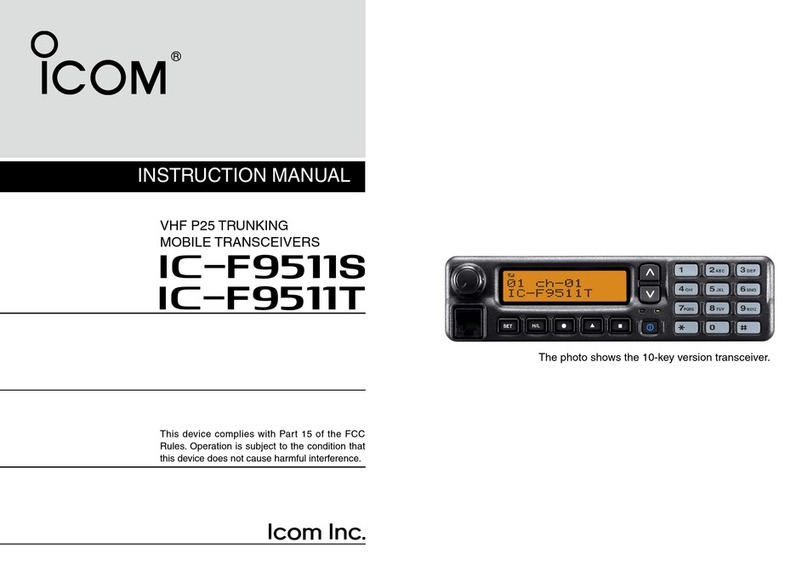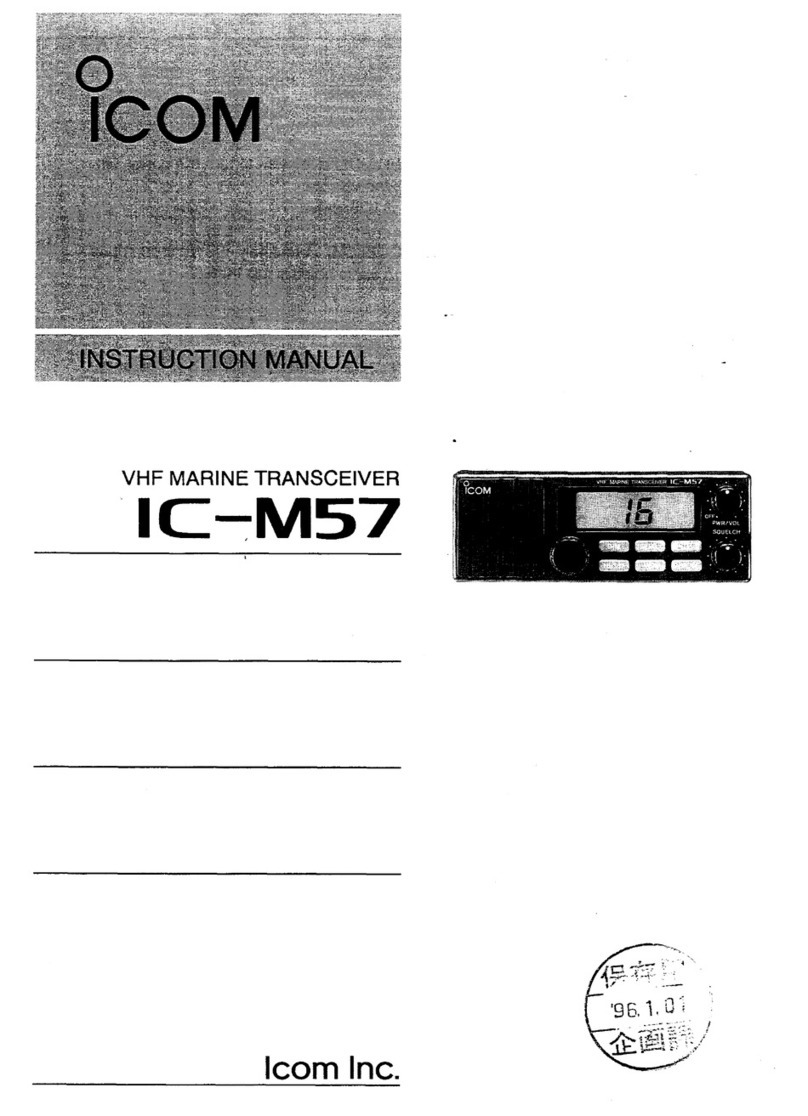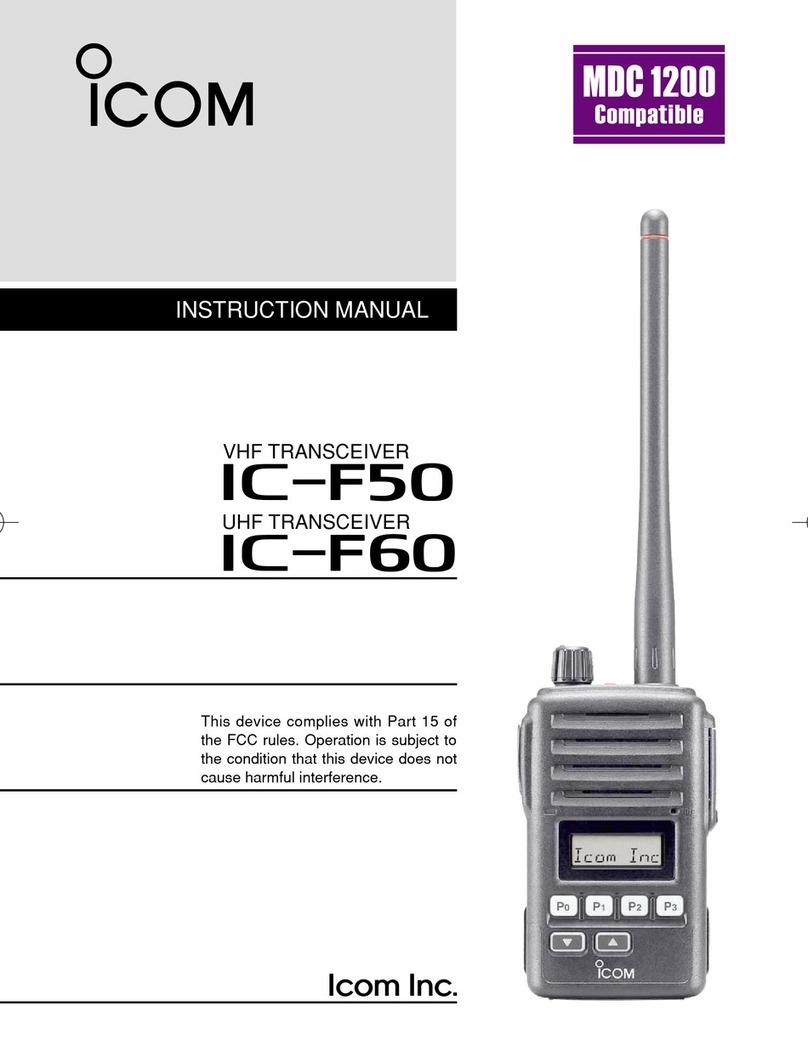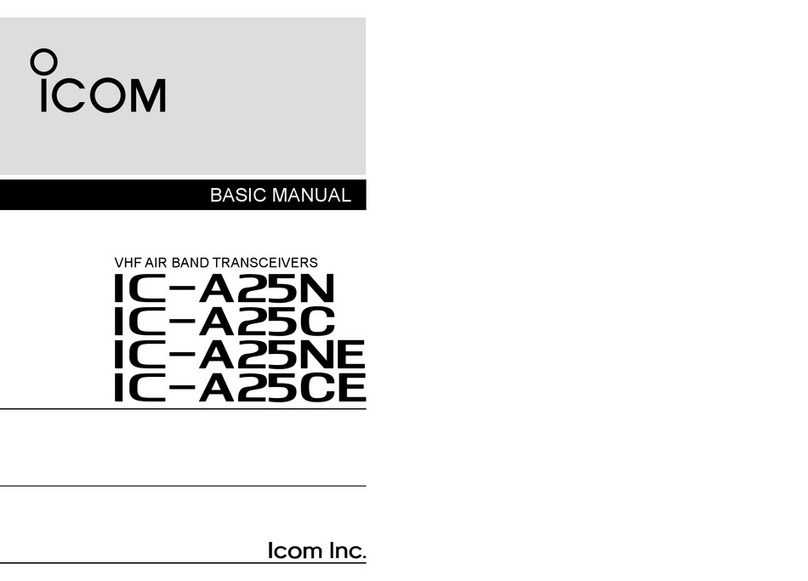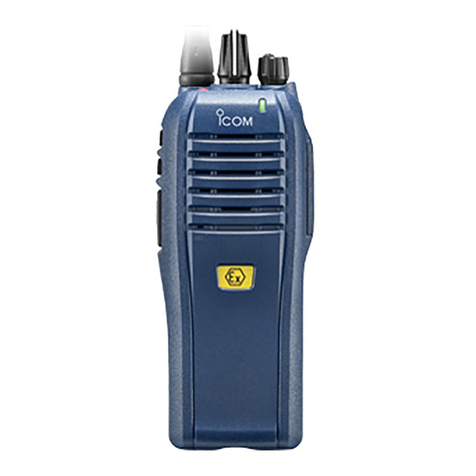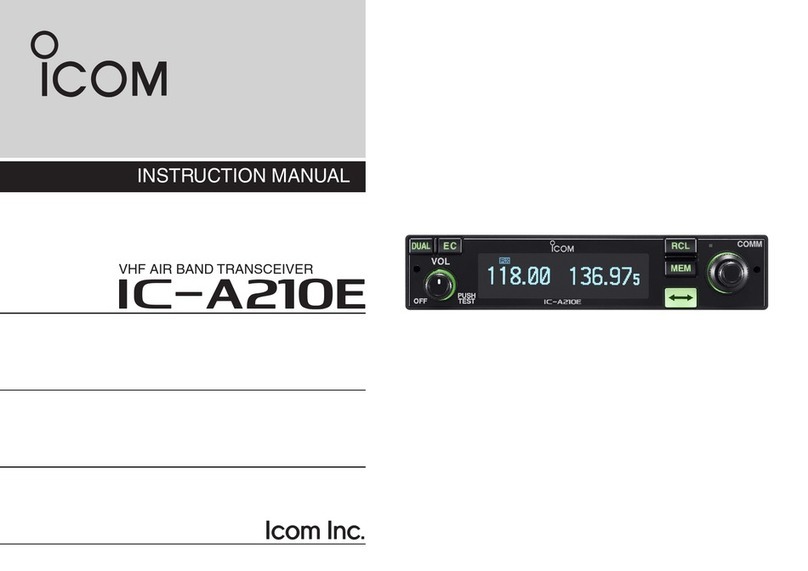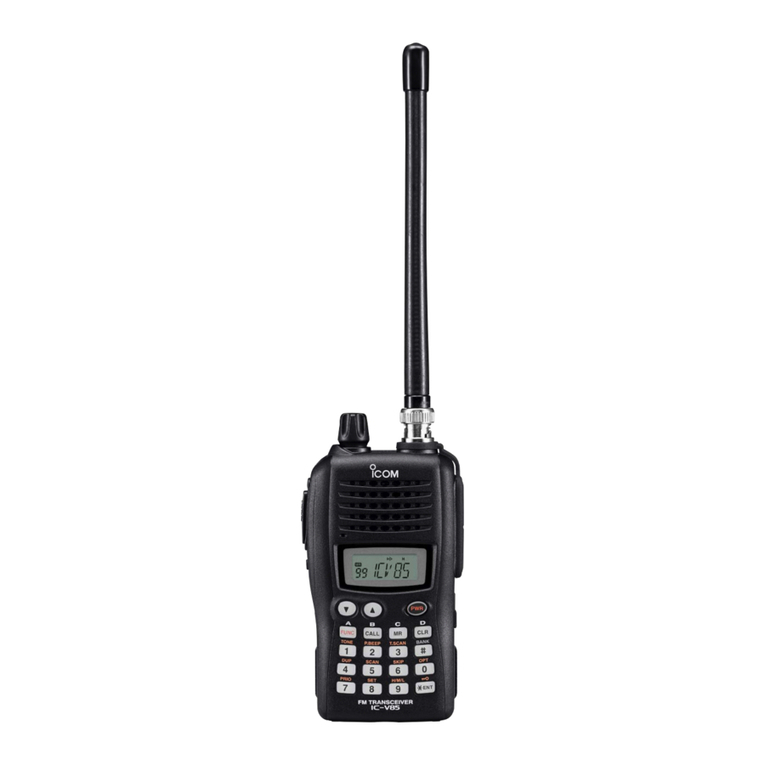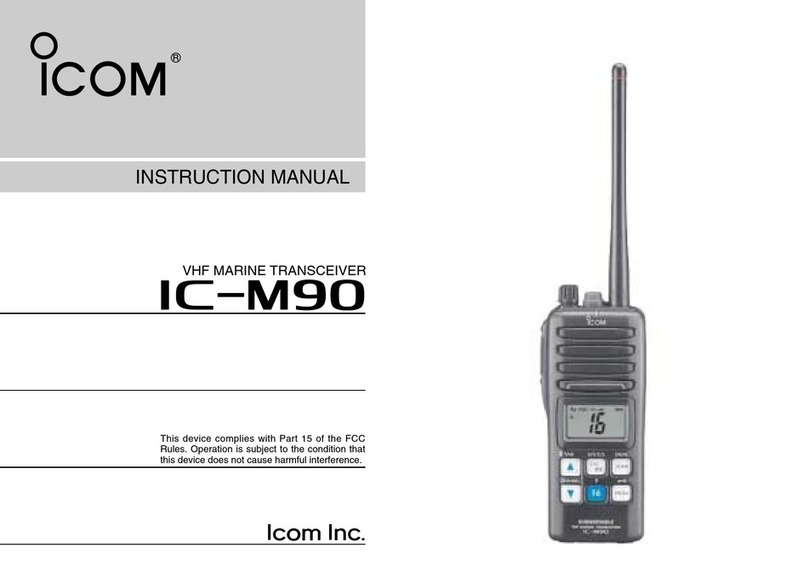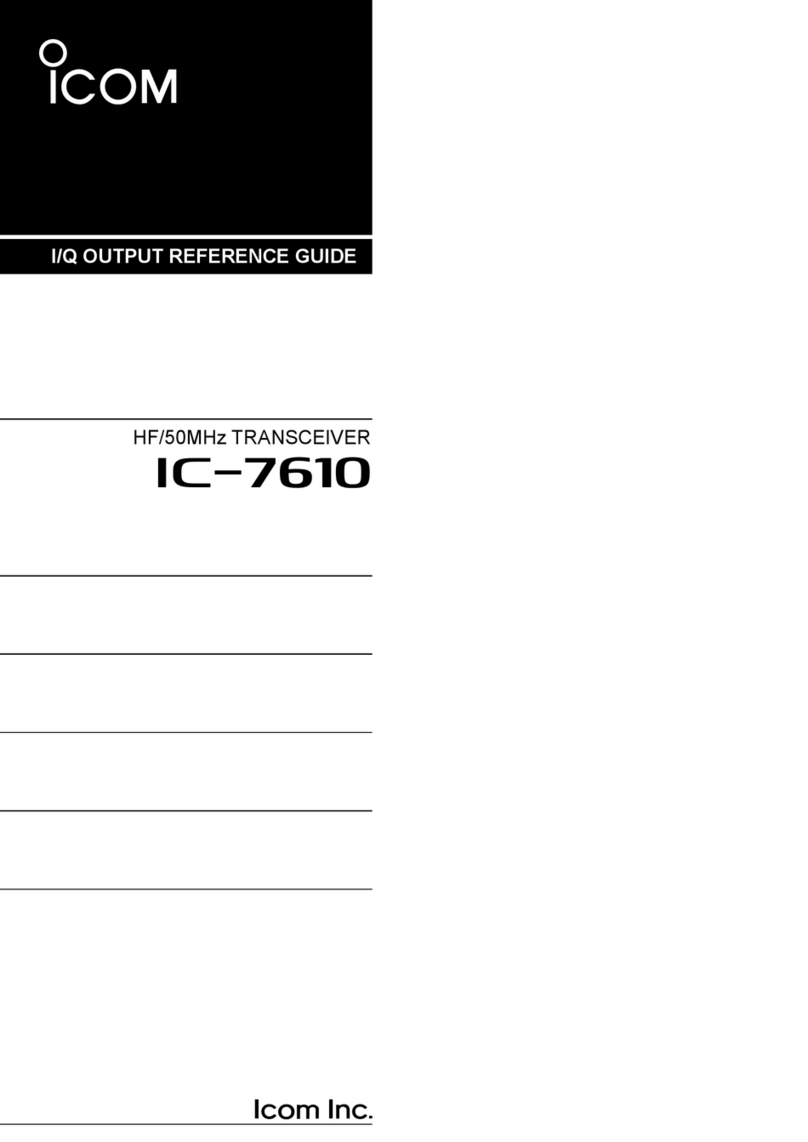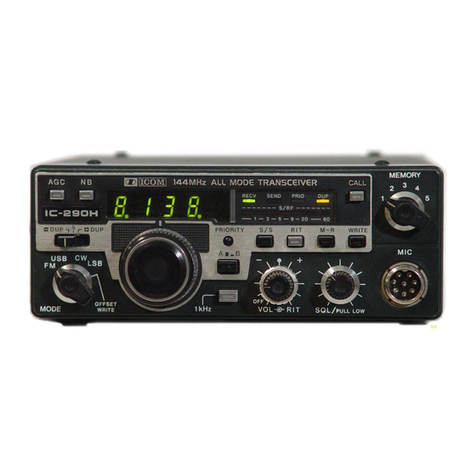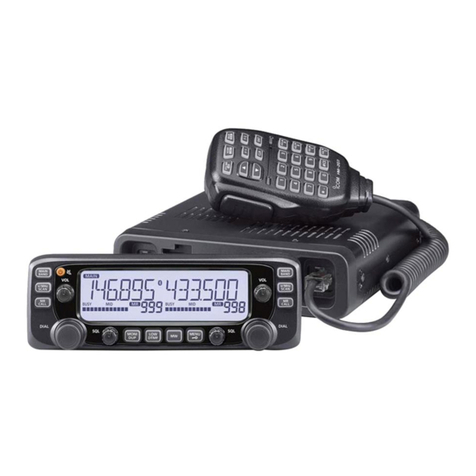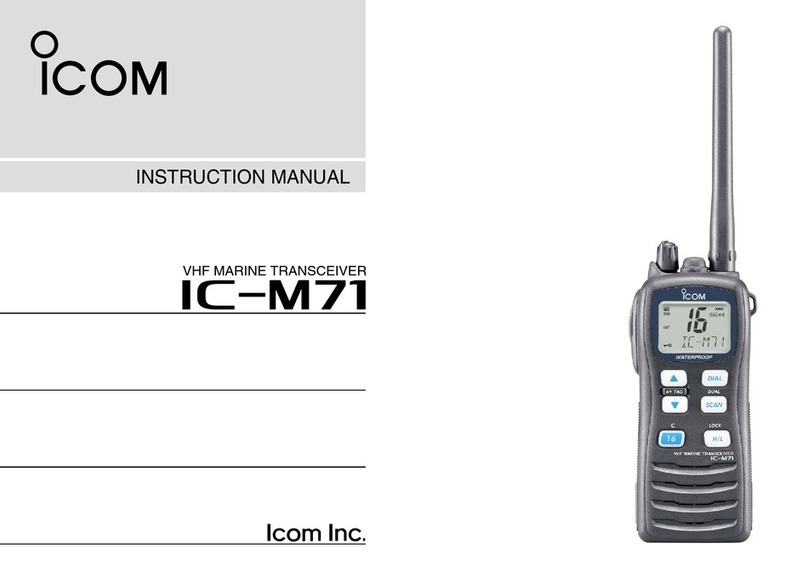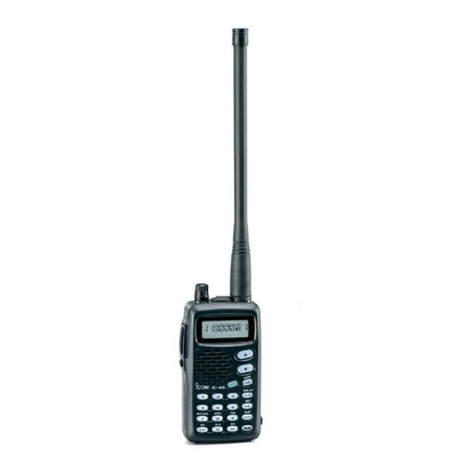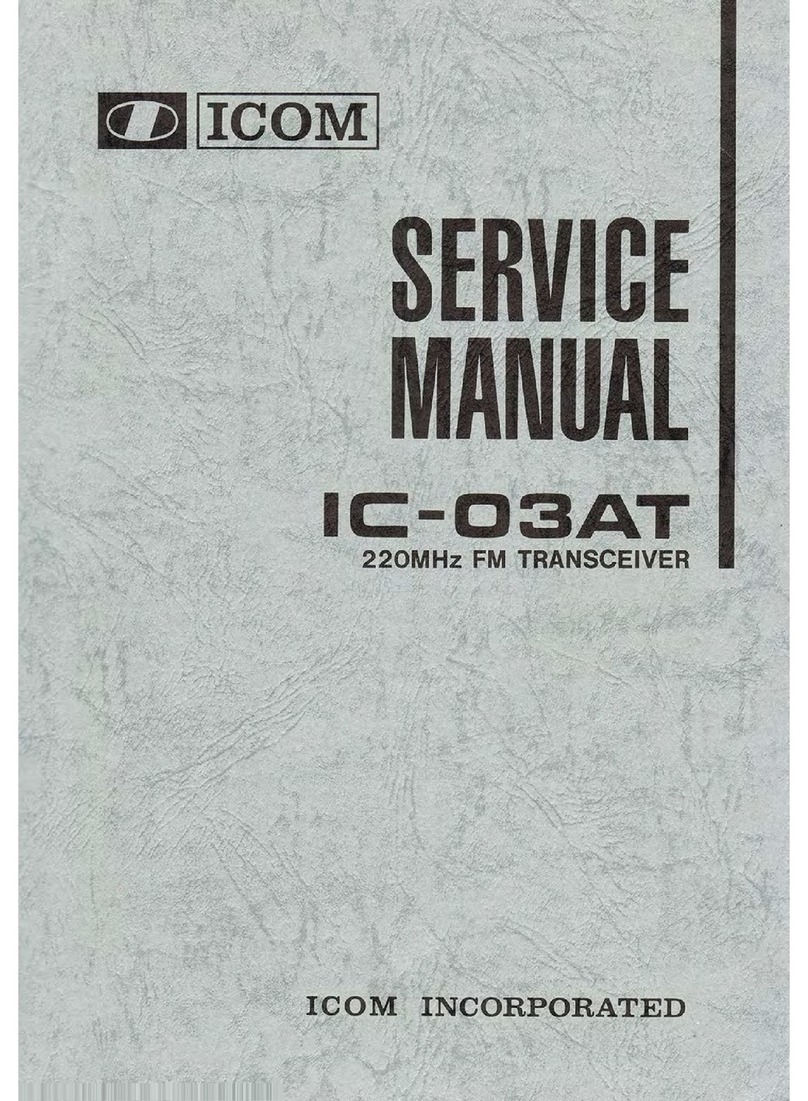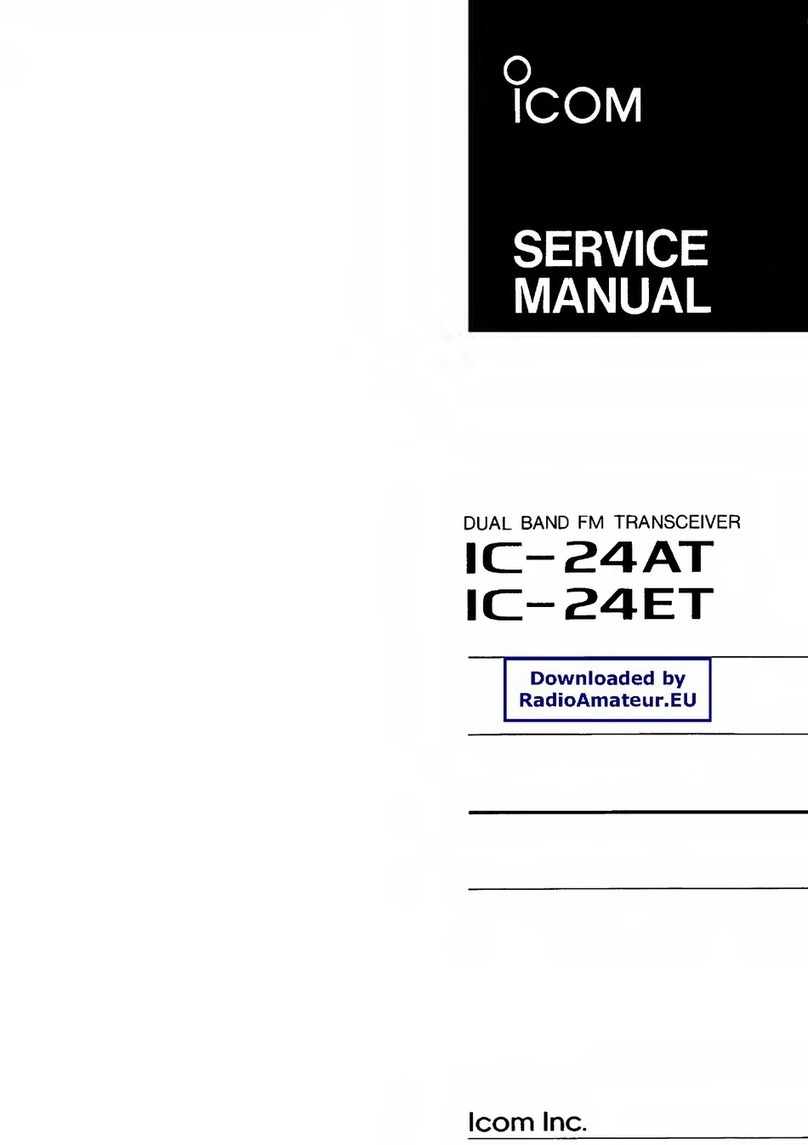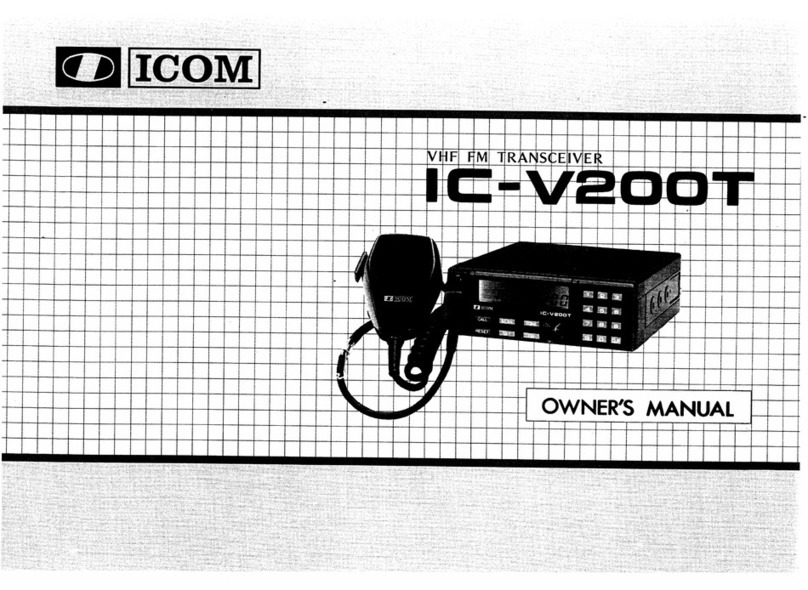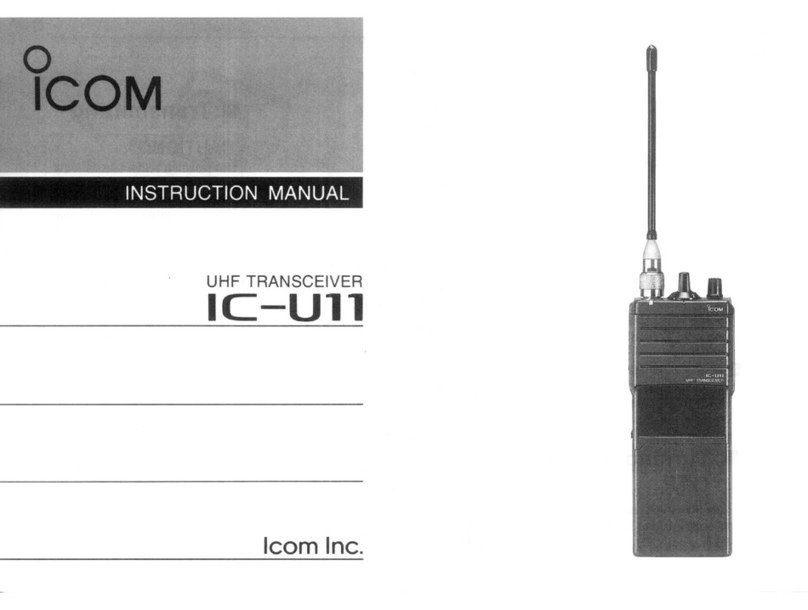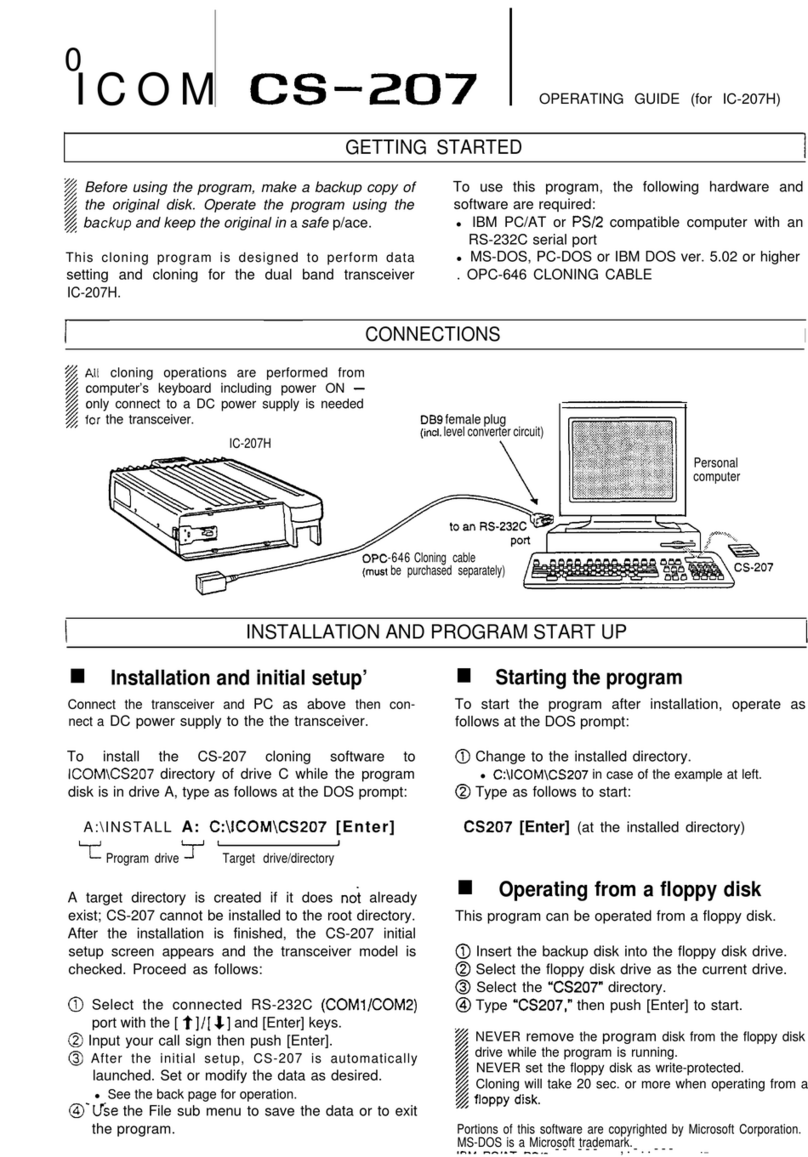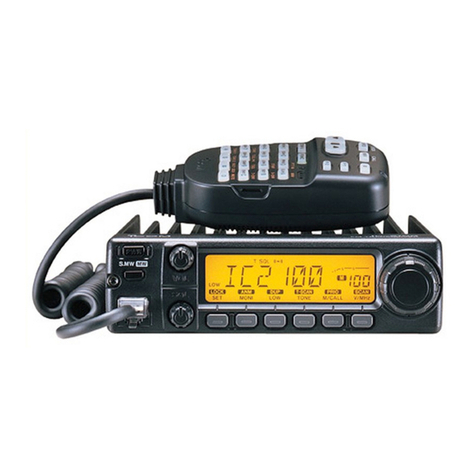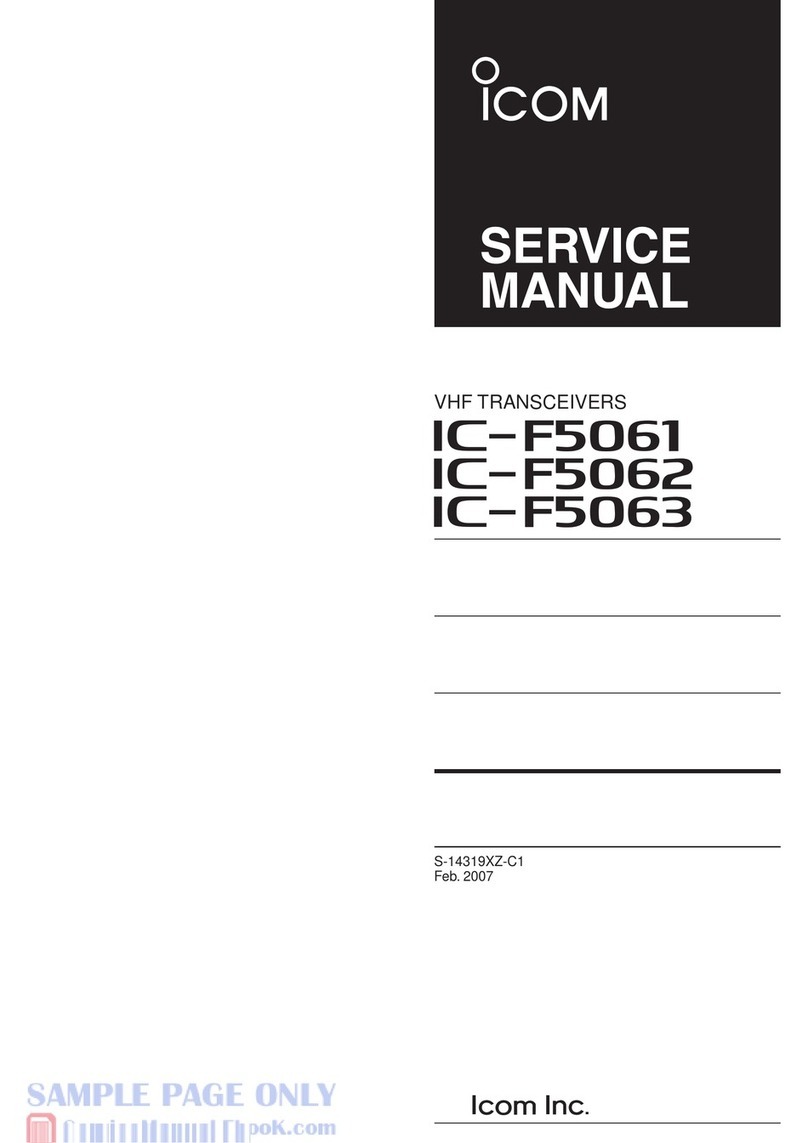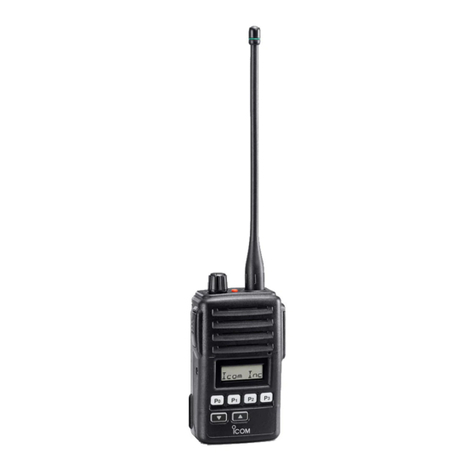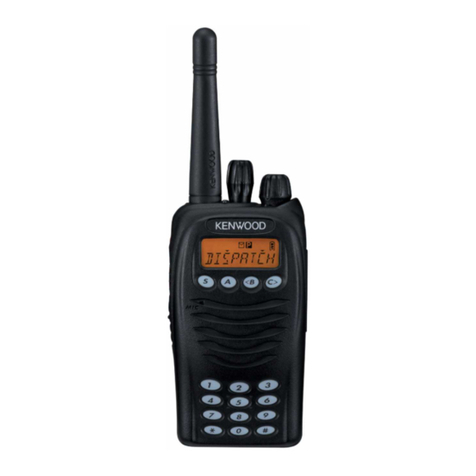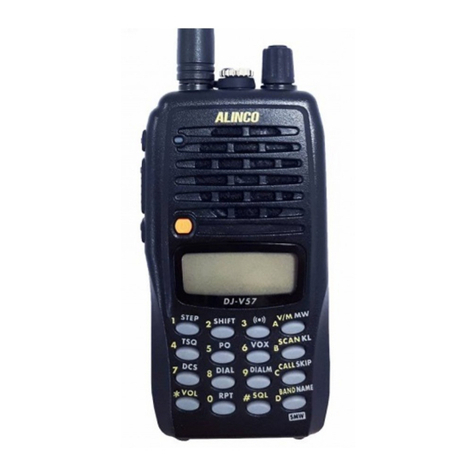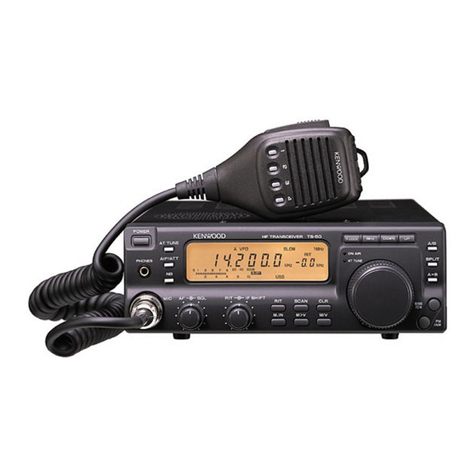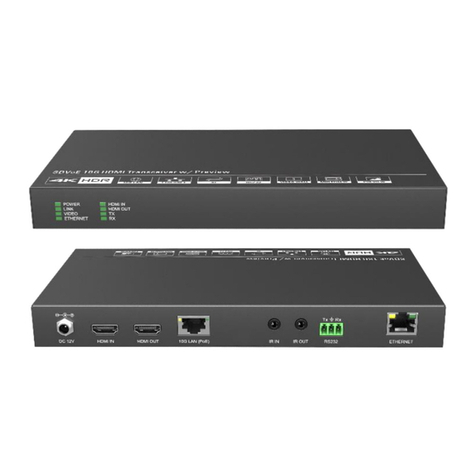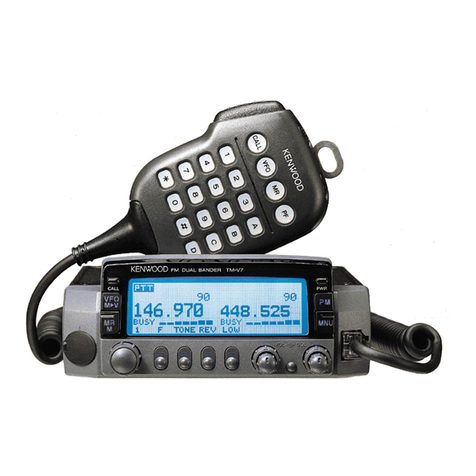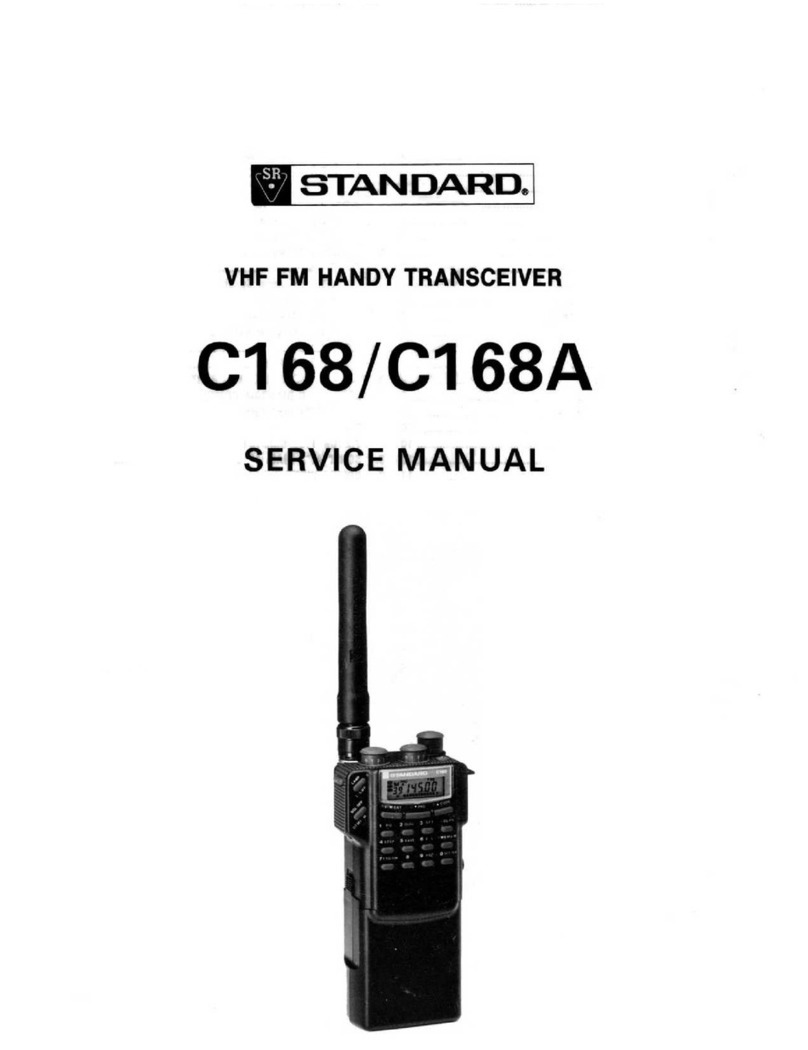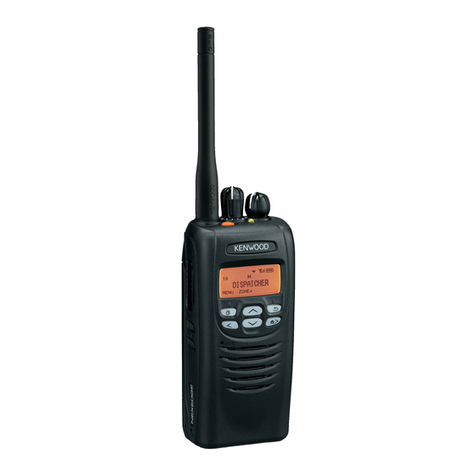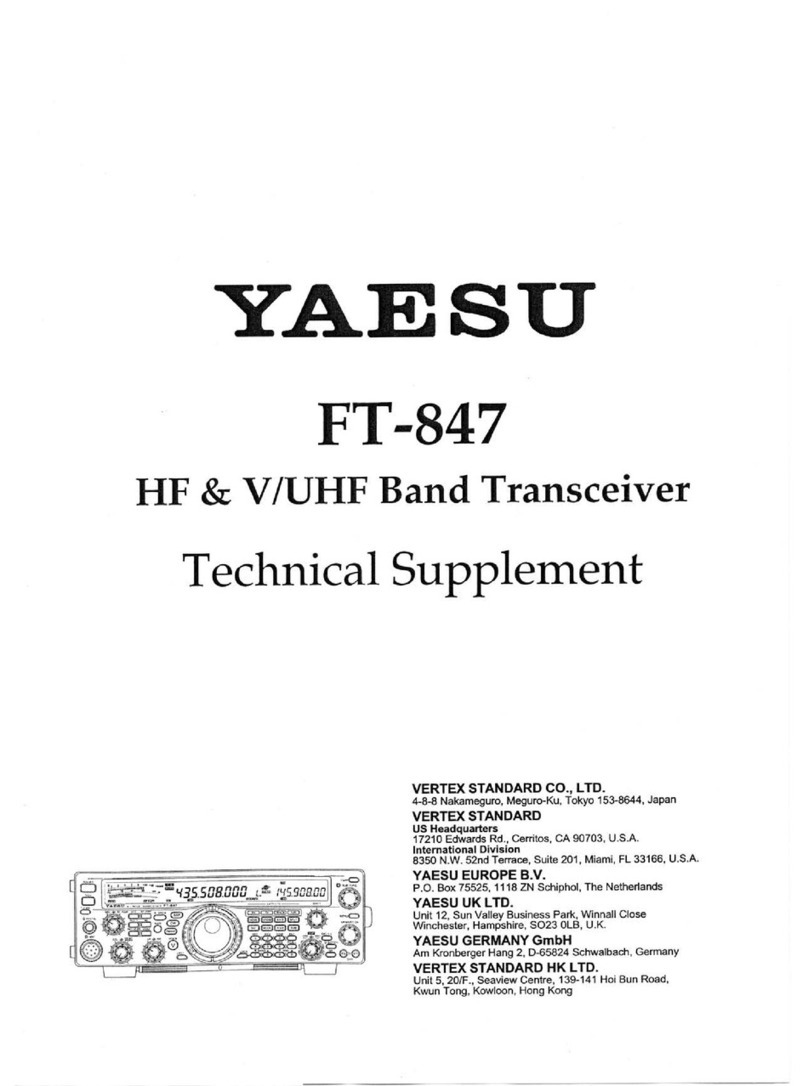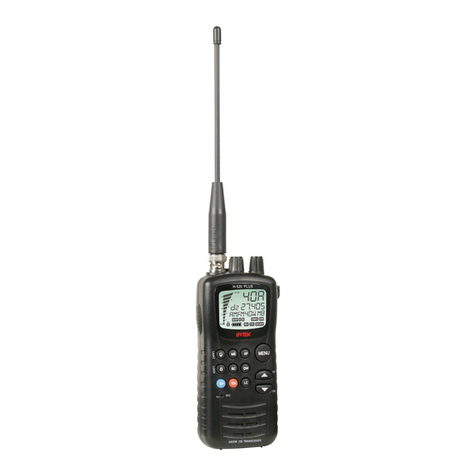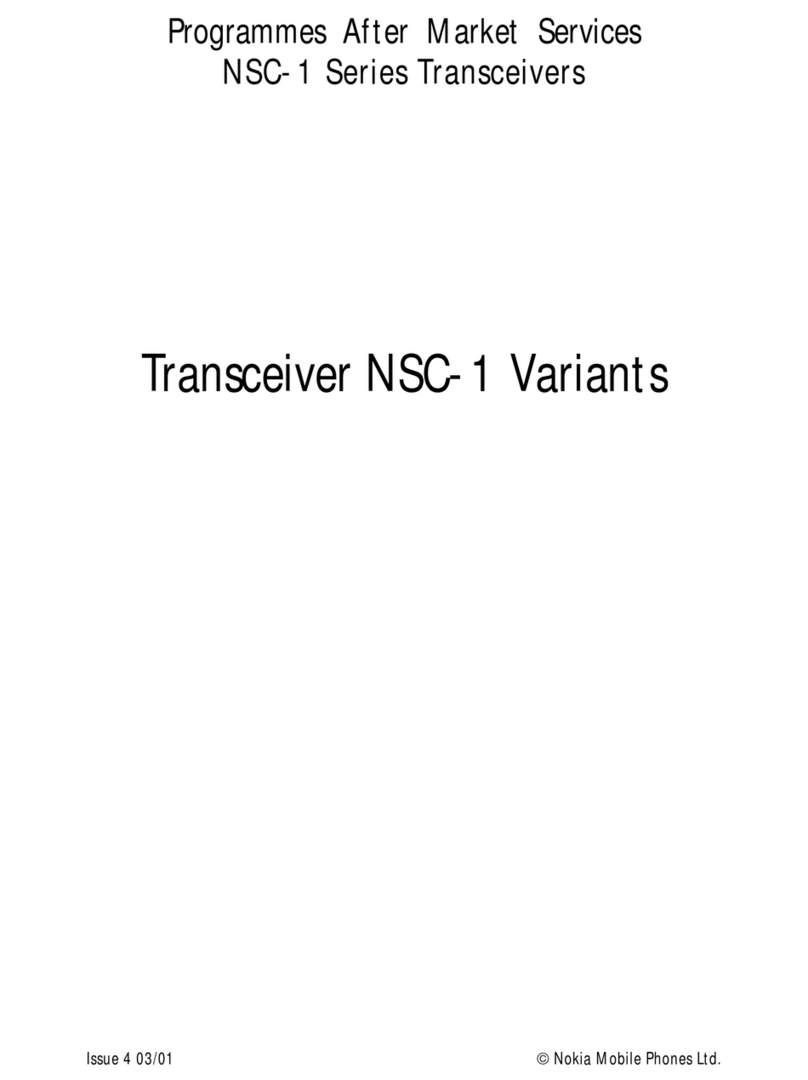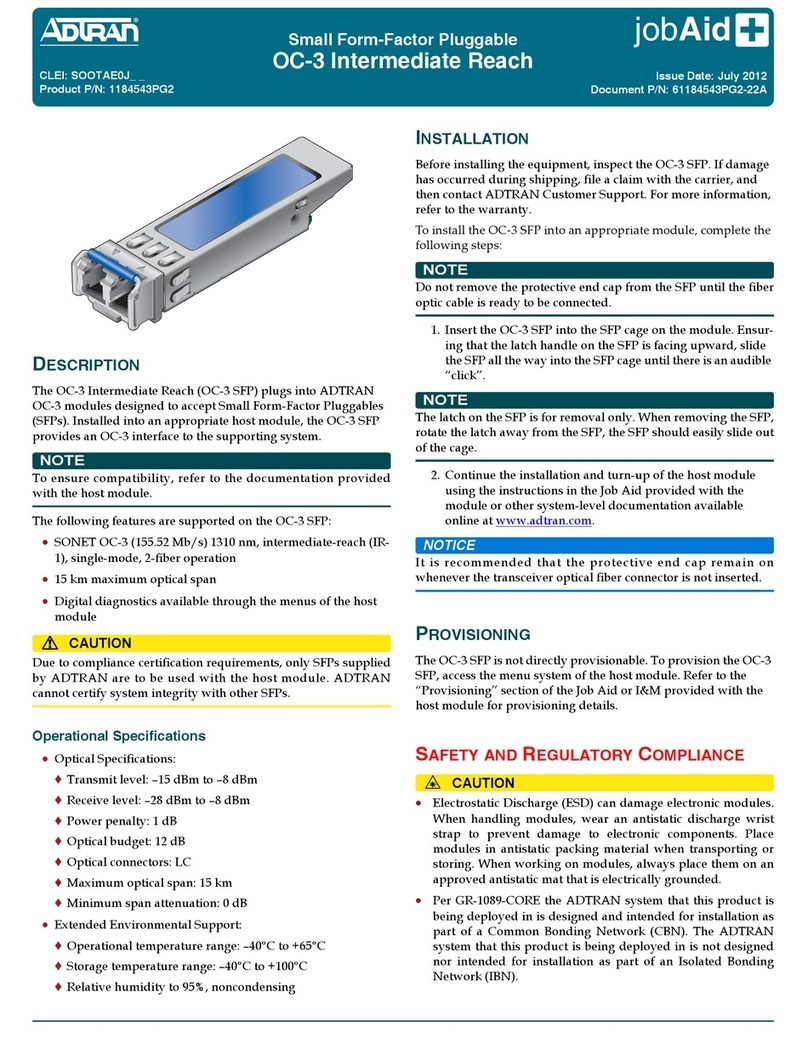Icom IC-725 User manual

HF
ALL
BAND TRANSCEIVER
IC-725
lcom
Inc.

INTRODUCTION
This service manual describes the latest service informa-
tion for the IC-725 HF ALL BAND
TRANSCEIVER
at the
time of going to press.
If
you
require assistance or further information regarding
the operation
and
capabilities of the IC-725, contact your
nearest authorized lcom Dealer or lcom Service Center.
ORDERING PARTS
Be
sure to include the following four points when
ordering replacement parts:
1.
10-digit order numbers
2.
Component part number and
name
3.
Equipment model name and unit name
4.
Quantity required
<SAMPLE
ORDER>
1110001310
IC
µPC577HA
IC-725
MAIN
UNIT
5pieces
8810005510 Screw
PHM3x6ZKBS
IC-725
Topcover 10pieces
Addresses are provided
on
the inside back cover for your
convenience.
DANGER
NEVER
connect the transceiver to
an
AC
outlet or
to a
DC
power supply that uses more than
16
V.
This
will ruin the transceiver.
DO
NOT
expose the transceiver to rain, snow or
any liquids.
DO
NOT
reverse the polarities of the power supply
when connecting
the
transceiver.
DO
NOT
apply
an
RF
signal of more than
20
dBm
(100
mW)
to the antenna connector. This could
damage the transceiver's front
end.
REPAIR NOTE
1.
Make sure a problem
is
internal before disassembling
the transceiver.
2.
DO
NOT
open
the transceiver until the transceiver
is disconnected from a power source.
3.
DO
NOT
force
any
of the variable components.
Turn
them slowly
and
smoothly.
4.
DO
NOT
short
any
circuits or electronic parts.
An
insulated tuning tool MUST
be
used for all
adjustments.
5.
DO
NOT
keep
power
ON
tor a long time
when
the
transceiver
is
defective.
6.
DO
NOT
tr~nsmit
power into a signal generator
or a sweep generator.
7 ALWAYS connect a
40
dB-50
dB attenuator between
the transceiver
and
a deviation meter or spectrum
analyzer
when
using
such test equipment.
8.
READ the instructions of test equipment thoroughly
before connecting equipment
to
the transceiver.

TABLE
OF
CONTENTS
SECTION
1
SPECIFICATIONS....................................................
1
-1
SECTION
2 INSIDE
VIEWS.
... ..... . .. . ... . .. .. . .. . .. .... .... . .... ... . .. .. .. ...... 2 - 1
-·2
SECTION
3
BLOCK
DIAGRAM
.. .. .. .. . .. .. .. .. .. . .. .... ... ... .... .. .. .. . ... ...... 3 - 1
SECTION
4 CIRCUIT
DESCRIPTION...............................................
4-1
-7
4 • 1
RECEIVER
CIRCUITS
. .. . . . . . . . . . . . . . . . . . . . . . . . . . . . . . . . .. . . . . . . . . . . . . . . .. . . . 4- 1
4 · 2
TRANSMITTER
CIRCUITS.
. . . . . . . . . . . . . . . . . . . . . . . . . .. . . . . . . . . . . . . . . . . .. . . . . . . 4 - 4
4 • 3
PLL
CIRCUITS.............................................................
4-6
4 · 4
LOGIC
CIRCUITS.
. . . . .. . . . . . . . . . . . . . . . . . . . . . . . . . . . . . . .. . . . . . . . . . . . . . . .. . . . . 4 - 7
4 • 5
REGULATOR
CIRCUITS
. . . . . . . . . . . . . . . . . . . . .. . . . . . . . . . . . . . . . . . . . . . . . .. . . . . . . 4 - 7
SECTION
5 MECHANICAL
PARTS
AND
DISASSEMBLY..................
.. ... ... .. 5
-1
.....,
7
5 · 1
FRAME
DISASSEMBLY
.................................
: . . . . . . . . . . .. . . . . . . . 5- 1
5 · 2
PA
UNIT
AND
ACCESSORIES
. . . . . . . . . . . . . . . . .. . . . . . . . . . . .. . . . . . . . . . . . . . . . . . . 5- 3
5 • 3
FRONT
AND
PLL
UNITS
CONNECTOR
ASSEMBLY. . . . .. . . . . . . . . . . . . . . . . . .. .. . . . . 5 - 5
5 •4
FRONT
AND
MAIN
UNITS
CONNECTOR
ASSEMBLY
. . . . .. . . . . . . . . . . . . . . . .. . . . . . . 5 - 6
5 • 5
PA
AND
FIL
TEA
UNITS
CONNECTOR
ASSEMBLY. . . . .. . . . . . . . . . . . . . . . . . .. . . . . . . . 5- 7
SECTION
6 ADJUSTMENT PROCEDURES. . .. .. . .. .. ... .... .. ..... ... . .. .. .. ...... 6 - 1-7
6·1
PREPARATION
BEFORE
SERVICING;..........................................
6-1
6 • 2
PLL
ADJUSTMENT
. . . .. . . . . . . . . . . . . . . . . . . . . . . .. . . . . . . . . . . . . . . . . . . .. . . . . . . . . 6
_.:
2
6 · 3
RECEIVER
ADJUSTMENT.
. . . . . . . . . . . . . . . . . . . .. . . . . . . . . . .. . . . . . . . . . . . . . . .. . . . 6 - 4
6 •4
TRANSMITTER
ADJUSTMENT
. .. . . . . . . . . . . . .
..
. . .. . . . . . . . .. . . . . . . . . . . . . . . . . . . . 6 - 6
SECTION
7
BOARD
LAYOUTS
.. .. .. . .. ... .. .. .. . .. ..... ... ... ..... .. .. .. .. ... .. .. 7 - 1
,....,
5
7 · 1
FRONT
UNIT
. . .. . . .. . . . . . . . . . . . . . . . . . . . . . . .. . . . . . . . . .. . . . . . . . . . . . .. . . . . . . . 7- 1
7 · 2
MAIN
UNIT
.......................................
· . . .. . . . . . . . . . . . . . . .. . . . . 7- 2
7 -3
PLL
UNIT. . . .. . . . . . . . . . . . . . . . . . . . . . . . . . . . .. . . . . . . .. . . . . . . . . . . . . . . . .. . . . . . . 7 - 3
7 · 4
PA
UNIT.
. . .. . . . . . . . . . .. . . . . . . . . . . . . . . . . . . .. . . . . . . . . . . .. . . . . . . . . . . . . .. . . . . 7 - 4
7 •5
DDS
UNIT
..............................................................
; . 7 - 5
7 · 6
AM
•
FM
UNIT
(OPTIONAL)
. . . . . . . . . . . . . . . . . .. . . . . . . . . .. . . . . . . . . . . . . . . .. . . . . . 7 - 5.
SECTION
8
PARTS
LIST
..........................................................
8-1-13
SECTION
9 VOLTAGEDIAGRAMS
................................................
9-1-2
9 • 1
FRONT
AND
MAIN
UNITS
. . . . . . . . . . . . . . . . . . .. . . . . . . . . .. . . . . . . . . . . . . .. . . . . . . . 9 - 1
9 • 2
PLL
AND
PA
UNITS
. .. . . . . . . . . . . . . . . . . . . . . . . .. . . . . . . . . . .. . . . . . . . . . . . . .. . . . . 9 - 2

SECTION
1
SPECIFICATIONS
•GENERAL
• Frequency coverage
•Modes
• Number of memory channels
• Antenna impedance
• Usable temperature range
• Frequency stability
• Power supply requirement
• Current drain (at 13.8 V
DC)
• Dimensions
•Weight
•TRANSMITTER
• Output power
• Spurious emissions
• Carrier suppression
• Unwanted sideband
•Microphone impedance
•RECEIVER
• Receive system
• Intermediate frequencies
• Sensitivity (preamplifier
ON)
•
FM
squelch sensitivity
• Selectivity
• Spurious response rejection
• Audio output impedance
• Audio output power
•
RIT
variable range
Receive 500
kHz-30
MHz
Transmit 160-m band
1.8-
2.0 MHz
80-m
band
3.5-
4.0 MHz
40-m
band
7.0-
7.3 MHz
30-m
band
10.1-10.15
MHz
20-m
band
14.0-14.35
MHz
SSB
(A3J),
CW
(A
1
),
AM
(A3),
FM
(F3)
17-m
band
18.068-18.168
MHz
15-m
band 21.0
-21.45
MHz
12-m
band 24.89
-24.99
MHz
10-m
band 28.0
-29.7
MHz
(Ul-7
AM
·
FM
UNIT is required for
AM
transmit and
FM
transmit/receive.)
26
50
a unbalanced
-10
°C-+60
°C
(+14
°F-+140
°F)
Less
than
±200
Hz
up to one hour after power is turned
ON.
Less
than
±30
Hz
after one hour at
+25
°C
(+
77
°F).
Less
than
±350
Hz
at 0
°C-+50
°C
(+32
°F-+122
°F).
13.8
V
DC
±15
%,
negative ground
Receive squelched 1.2 A max. audio output 1.5 A
Transmit
20
A
241
(W)
x
94
(H)
x 239
(D)
mm (Projections not included)
9.5
(W)
x
3.7
(H)
x 9.4
(D)
in
4.6
kg
(10.1
lb)
SSB,
CW,
FM
10-100
W continuously adjustable
AM
10-40
W continuously adjustable
More than
50
dB below peak output power
More than
40
dB below peak output power
More than
50
dB down with 1 kHz
AF
input
6000
SSB,
CW,
AM
Double-conversion superheterodyne
FM
1st
SSB
Triple-conversion superheterodyne
70.4515 MHz
cw
70.4506 MHz
AM,
FM
70.4500 MHz
2nd
SSB
9.0115 MHz
CW
9.0106 MHz
AM,
FM
9.0100 MHz
3rd
FM
455 kHz
SSB,
CW
(10
dB S/N)
1.8-30
MHz Less than 0.15 µV
(-123
dBm)
AM
(10
dB
SIN)
0.5-1.8
MHz
Less
than 13.0 µV
(-85
dBm)
1.8-30
MHz Less than 2.0 µV
(-101
dBm)
FM
(12
dB
SINAD)
28-30
MHz Less than 0.5 µV
(-113
dBm)
Less
than 0.3 µV (preamplifier ON)
SSB,
CW
More than 2.3
kHz/-6
dB
AM
More than 6.0
kHz/-6
dB
FM
More than
15
kHz/-6
dB
More than
70
dB
an
Less
than 4.0
kHz/-60
dB
Less
than 20.0
kHz/-40
dB
Less
than
30
kHz/-50 dB
More than
2.6
W at 1o% distortion with
an
8 a load
More than ± 1 kHz
All stated specifications are subject to change without notice or obligation.
1-1

SECTION
2
INSIDE
VIEWS
•
PLL
UNIT
A/D
converter------
(IC12: MB4052M-G)
Cl-V
interface-------=
Cl-V diode
matrix-----
CPU
(IC8:
HD63A01YOG83P)
Lithium
backup
battery---
+5
V
regulator-------=
(IC10: TA78005AP)
Sensor
circuit------
Band voltage
buffer----....;:;;,:..,.,.-""""
(IC9: M54562P)
•MAIN
UNIT
Rx
bandpass filters ------=-
Rx
1st
mixer
circuit-----+
Tx 2nd mixer
circuit---_...
MCF (Fl1:
FL-71)-----,
Noise blanker
circuit-----
Rx
2nd/Tx
1st
mixer----:
(IC1: ND487C1-3R)
MCF (Fl2:
FL-23)----~====!-i..--I
9 MHz SSB •
CW
filter
(Fl3: FL-30)
2-1
-----1st
LO
amp
circuit
Phase detector/Prescaler
------Sub
loop
VCO
c---------DDS
UNIT
-:::-------2nd
LO circuit
'---------=;----Reference
crystal
(X2:
CR-21
30.72
MHz)
Divider (IC15: M74ALS74AP)
Space for Ul-7 AM • FM UNIT
+------APC/ALC
circuit
'+--------
BFO circuit
;.;------SSB
modulator
(IC6: µPC1037HA)
~----Product
detector
(IC5: µPC1037HA)
----Rx
2nd IF amplifier
.------9.01
MHz
AM filter
(Fl4: FL-116)

•
PA
AND
FILTER
UNITS
Tx/Rx switching
relay-----;;.-=:-;;-
(RL13: DS1-M-DC12V)
--------Predrive
amplifier
(01:
2SC1971)
~----Drive
amplifier
(02,
03:
2SC3133)
'=+----Final
amplifier
(05,
06:
2SC2904)
-'------Thermal
switch
(81: OHD-3 90M)
2-2

c.>
I
....
a:~Tr~N
1
.-1
, • ,,. <
022
2SK241
I
14
I~
~I
+•
TB
••·••)b
~
SW
-+~
DELAY
..
MAIN
UNIT
!lb
2nd
mlur.1
Tx
!ti
mixer
TXC
""
~I
'.
RF
POWl!:R
CTRL
13.BV
o----<---------
13.81/
0.151"\..1,IMHz
ATT
SW
T1
2nd
mlur
PA
UNIT
~
"~8MH;
~
,,
..,----L:..:._jJ
3.5MH~
~
.,
....------L::._jj-
--7.0MH;
07.8
IK&OX2
ANT
--------------~~;~
015,
17,
,.,
21
-r::;;l
I
~-1·--·-
---
-
VCOI •
70.H15"'-
71.4514MH1
VC02
'78.4&15""
85.4&f4MHz
VC03
'85.4514.,,.
92.4514MHr
VC04
'92.40115"
100.451!5MHz
PLL UNIT
IC17
pPCI037H
2SK112A
)f4
PA
LPF
BUFF
Lt
...
LI
I
I
01
MVO
Q4
2801406
D2,3
MV5X2
',
QT
2SBOl2
I
··~
0
~
L---------
•••
DATA
CPU
tea
HD83AOIY
IC12 M84052
MAIN
DUL
RIT
I-
s & • VFO. MHr •IC.
DISPLAY
D~
IC4
pPD4069
IC6
BA222
~
-151/ 13.81/
v

SECTION
4
CIRCUIT
DESCRIPTION
4·1
RECEIVER CIRCUITS
4-1·1
RF SWITCHING CIRCUIT
(PA AND MAIN UNITS)
RF
signals from the antenna connector pass through the
transmit/receive switching relay
(RL13)
and a low-pass
filter,
and
are applied to the
MAIN
UNIT via
P2
(MAIN
UNIT:
J12).
The
signals from the
PA
UNIT either bypass or are
attenuated at
20
dB
attenuator
(R102,
R103,
RL1).
There
are no non-linear components between the antenna
connector
and
attenuator to prevent distortion caused
by strong signals. The signals are then applied to
RF
filters.
4·1·2 RF BANDPASS FILTER CIRCUIT
(MAIN UNIT)
The
RF
UNIT
has
7
RF.
bandpass filters
(BPF)
for signals
above 1.6
MHz
and
1 low-pass filter
(LPF)
for signals below
1.6
MHz.
The
signals pass through one of the bandpass
or low-pass filters depending
on
the receive frequency
range.
(1)
0.5-1.6
MHz
A diode
is
not used at the low-pass filter entrance
removing diode distortion from very strong signals.
Signals bypass a preamplifier by the bypass switch (012).
(2)
1.6 MHz AND ABOVE
Signals are applied to a high-pass filter consisting of
L42,
L43,
C143-C146. This filter suppresses strong signals
below 1.6
MHz
such
as
a broadcasting station.
The
filtered signals are applied to one of 7 bandpass filters
depending
on
the frequency of the signals
and
then to the
preamplifier circuit (08, 09).
(3)
FILTER SWITCHING CIRCUIT
An
RF
bandpass filter is selected with
BPF
switching
voltage (BO-B7) from the
CPU
via
IC16
current amplifier.
The
switching voltage of the
BPF
entrance is higher than
the
BPF
exit to improve multi-signal
and
strong signal
characteristics.
4·1·3 PREAMPLIFIER CIRCUIT (MAIN UNIT)
The
preamplifier circuit uses low-noise junction
FETs
(2SK125 x
2)
to provide 1O
dB
gain over a wideband
frequency
range.
When
the
[PRE]
switch is turned
ON,
the signals from
the
RF
filter are amplified by the preamplifier circuit (08,
09).
When
the
[PRE]
switch
is
turned
OFF,
the signals
bypass the preamplifier through 030
and
032.
When
the
operating frequency is below
1.6
MHz,
012 turns
ON
and
the signals bypass the preamplifier regardless of the
[PRE]
switch.
4-1
Amplified or bypassed signals are applied to the 1st mixer
circuit via the low-pass filter. The low-pass filter cuts
off at
35
MHz to suppress image frequency at the 1st
mixer circuit (013, 014).
PREAMP CIRCUIT
RF
signal
from BPF
030
Q10
Fig.1
4·1·4 1ST MIXER CIRCUITS (MAIN UNIT)
The signals from the low-pass filter enter the 1st mixer
circuit (013, 014) to
be
converted to a 70.45 MHz
tst
IF
signal.
EXACTNESS 1ST
IF
FREQUENCY
MODE
FREQUENCY
(MHz)
SSB
70.4515
cw
70.4506
AM,
FM
70.4500
The 1st mixer circuit employs a balanced mixer using
low-
noise junction
FETs
(2SK125 x
2)
to expand the dynamic
range.
The
1st
LO
signal (70.9515-100.4515
MHz)
enters
the
MAIN UNIT from the
PLL
UNIT via
J5.
The
signal
is
amplified at 04, filtered by a low-pass filter, and
then
applied to the 1st mixer circuit (013, 014). The
low-pass
filteremploys a ring core inductortoprevent 1st
LO
leakage
signals.
The
output level from
04
is approx.
25
dBm.
The 1st IF signal is applied to
an
MCF
(Monolithic Crystal
Filter;
Fl
1)
to suppress out-of-band signals. The signal
is
amplified at the 1st
IF
amplifier (015), and then applied
to the 2nd mixer
(IC1).

4·1·5
IF
CIRCUITS (MAIN UNIT)
The 1st
IF
signal from
015
is
converted to a 9 MHz 2nd
IF signal at the 2nd mixer
(IC1).
IC1
is a
DBM
(Double
Balanced Mixer).
EXACTNESS
2ND
IF FREQUENCY
MODE
FREQUENCY
(MHz)
SSB
9.0115
cw
9.0106
AM,
FM
9.0100
The 2nd
LO
signal (61.44
MHz)
from the
PLL
UNIT via
J4
is applied to the 2nd mixer.
The
converted 2nd
IF
signal
passes through
D4
(D35 for transmitting)
and
is applied
to the
MCF
(Fl2) to suppress unwanted signals.
The
signal output from Fl2 passes through the noise
blanker gate
(D5-D8)
and is amplified at the 2nd IF
am-
plifier (021).
The
signal enters one of the three 9 MHz
filters (Fl3, Fl4, optional
CW
narrow filter) or optional
AM
·
FM
UNIT via D52. The filters are selected with mode
selecting signals
(SSB
·CW,
AM,
CW-N)
and the "TB"
voltage line.
The signal from a 9 MHz filter
is
amplified at the 2nd
IF
amplifiers
(027-029)
and applied to the demodulator
circuit.
Dual-gate
FETs
are used
on
the 1st and 2nd
IF
amplifiers
(015, 021, 027). The 2nd gates of 015, 021 and
027
are
controlled by
AGC
bias voltage. A rapid time constant
is used for 027 to prevent raising the edge distortion of
receive signals.
R140, connected to the gate of 028, improves the
temperature characteristics of the receiver gain.
R138
adjusts the receiver gain.
IF
CIRCUIT
AF signal SQL
IC8
BFO
SSB DET
AM
OET
062
4·1·6 NOISE BLANKER CIRCUITS
(MAIN UNIT)
The
IC-725
uses a noise trigger noise blanker circuit that
cuts out pulse-type noise signals at the noise blanker gate
(D5-D8).
A portion of the signals from Fl2 is amplified at the noise
amplifiers (016,
IC2)
and
detected at the noise detector
(D12,
D13).
The
detected voltage from the noise detector
is applied to the noise blanker switch (019).
The threshold level of the noise blanker switch
is
set
at
0.9
V.
When the detected voltage exceeds the threshold
level,
020
outputs a blanking signal to activate the noise
blanker gate
(05-08).
A portion of the detected voltage is applied to the noise
AGC
circuit (018) and fed back to the noise amplifier
(IC2)
as noise
AGC
voltages. The time constant of the noise
AGC
circuit
is
determined by
R43,
R47
and
C60.
This
AGC
circuit does not operate to detect pulse-type noise.
When the operating frequency or mode is changed, the
"ONB"
signal line becomes "LOW," turning
020
ON.
The
noise blanker gate prevents
PLL
click noise.
4·1·7
BFO
CIRCUIT (MAIN
UNln
A 9 MHz signal oscillated at the
BFO
circuit (031,
X1)
is buffer-amplified at
042
and used at the balanced
modulator
(IC6)
and a product detector
(IC5).
The
BFO
frequency is shifted with a mode signal using
067-069.
In
USB
mode, the "USB" signal line becomes "HIGH,"
turning
ON
069.
The
frequency
is
then adjusted with
C294 to set the
USB
carrier point.
At
CW
mode transmitting, the
"CW"
signal line becomes
"HIGH"
and
033
becomes OFF, turning
ON
068.
The
frequency
is
then adjusted with
L83
to set the
CW
transmit carrier point.
In
LSB
mode, the "LSB" signal line becomes "HIGH,"
turning
ON
067. The frequency
is
then adjusted with
L82 to set the
LSB
carrier point.
NOISE
BLANKER
Fig. 2
059,
060
4-2

BFO FREQUENCY IN EACH MODE
MODE
FREQUENCY
(MHz)
USB
9.0130
CW
(Tx)
9.0106
LSB
9.0100
CW
(Rx)
9.0098
AM
NO
OUTPUT
4·1·8 DEMODULATOR CIRCUITS
(MAIN UNIT)
The
IC-
725 has 2 detector circuits, a product detector
and
a diode detector to demodulate the
SSB,
CW
signal
and
AM
signal respectively.
In
SSB
or
CW
mode, the 2nd
IF
signal from the
IF
amplifier
(029) is mixed with the BFO signal at the product detector
(IC5)
to demodulate the 2nd
IF
signal into
an
AF
signal.
The
detected signal passes through the
AF
input mode
selector switch
(IC8).
In
AM
mode, the 2nd IF signal from
029
passed through
C121
is detected at D62 and passes through the
AF
input
mode selector switch (IC8).
4-1·9
AF
INPUT MODE SELECTOR SWITCH
(MAIN UNIT)
The
AF signal from a detector circuit or the optional
AM
·
FM
UNIT is applied to the
AF
input mode selector switch
(IC8).
IC8
consists of 4 analog switches
and
they are
selected with a mode signal from
IC15
and
the squelch
control signal. The AF signal
is
applied to the
AF
amp
circuit.
IC8 AF INPUT MODE SELECTOR SWITCH
MODE
ACTIVATING
CONTROL
PIN
NUMBERS
PIN
NUMBER
USB,
CW
2-1
13
AM
3-4
5
FM
10-11
12
ANY
MODES
9-8
6
(for S-meter)
AGC, S-METER
AND
SQUELCH CIRCUIT
Squelch signal
av
S.meter
signal FM S·meter
signal
SQLS
to
[RX)
indicator
Fig. 3
4-3
4·1·10 AF AMP CIRCUIT (MAIN UNIT)
The
AF
signal from the
AF
input mode selector switch
is
applied to the
AF
preamplifier (035, 036). The
CW
sidetone signal
is
applied to 036.
The
output from the
AF
preamplifier is applied to the [AF]
control
(FRONT
UNIT,
R1
b)
and the 2.8 kHz cut-off active
low-pass filter (037). The
AF
signal
is
power-amplified at
IC9
to drive the speaker.
4·1·11 AGC AND S·METER CIRCUIT
(MAIN UNIT)
The
receiver gain
is
determined by the voltage on the
AGC
line (030, collector).
When
strong signals are received,
the
AGC
circuit decreases the voltage
on
this line.
The
IF
signal from the IF amplifier (029) passes through
C117,
is detected at
D59
and 060,
and
applied to the base
of 030. A time constant
(C113,
R120)
is connected
to
the
AGC
line that determines the
AGC
release time.
The
time constant
is
controlled by the [AGC] switch.
When
the [AGC] switch
is
pushed
OUT,
C112 and R119 are
connected
in
parallel with the
AGC
line to obtain a slow
AGC
release time.
The
AGC
bias voltage
is
applied to the differential amplifier
(IC4,
pin
6)
where the difference between the bias
and
reference voltages
is
detected.
The
resulting S-meter
signal passes through the meter switching circuit
(IC8)
and is then applied to the meter
on
the front panel.
The
reference voltage
is
adjusted with
R116.
IC8
pins 8
and
9 are connected inside the
IC
in
receiving.
The
FM
S-meter signal from the optional
AM
·
FM
UNIT
is
applied to the meter switching circuit
(IC8)
via 057.
The
signal is also applied to the squelch circuit
(IC4
pin
2).

4·1·12 SQUELCH CIRCUIT (MAIN UNIT)
The
squelch circuit mutes the audio output when the
S-
meter signal
is
lower than the [SOL] control setting level.
The
S-meter signal from
IC4
pin 7 is applied to the
comparator
(IC4
pin
2)
to
be
compared to a threshold
level controlled by the
[SOL]
control. The squelch control
signal is applied to control terminals of the
AF
input mode
selector switch
(IC8).
When
the S-meter signal
is
lower than the threshold level,
the comparator turns "HIGH" and then
032
turns
OFF
to
deactivate the
AF
input mode selector switch. This
signal is applied to 034, turning OFF the [RX] indicator
and is also applied to the [MIC] connector pin 4.
4·2 TRANSMITTER CIRCUITS
4-2·1
MIC AMPLIFIER (MAIN
UNln
Audio signals from the [MIC] connector are applied to the
[MIC] control and amplified at the mic amplifier (045).
External modulation input from the [ACC(1)] socket pin 4
is
also applied to
045
via
R255.
The
AF
signals from 045 or
CW
keying signal is applied
to the balanced modulator
(IC6).
044
cuts the signals
from
045
in
CW
or receiving.
4-2·2 BALANCED MODULATOR (MAIN
UNln
Output signals from the mic amplifier or
CW
keying signal
are applied to the balanced modulator circuit
(IC6)
to be
converted to a 9
MHz
IF
signal using a
BFO
signal.
The
BFO
signal, buffer-amplified at 042, is applied to
IC6
pin
7
as
a carrier signal.
IC6
outputs a double sideband signal
and passes through a 9
MHz
filter to create
an
SSB
signal.
R177
and
R179
adjust the balance level of
IC6
for
maximum carrier suppression.
In
CW
mode, the
CW
keying signal upsets the balance to create a carrier signal.
4·2·3 IF CIRCUITS (MAIN
UNln
The
9
MHz
IF
signal passes through one of the three
9 MHz filters where unwanted sideband or out-of-band
signals are removed.
The
filters are selected with mode
selecting signals
and
the "T8" voltage line. The optional
CW
narrow filter
is
not
used
in
transmitting.
The
resulting signal
is
amplified at 022, and is then mixed
with the 2nd
LO
signal to
be
converted to a 70.45 MHz IF
signal at
IC1.
IC1
is
used
in
receiving and transmitting.
The
FM
signal from the optional
AM
·
FM
UNIT is amplified
at
022
and
is then applied to
IC1.
The
70.45
MHz
IF
signal is amplified at the
IF
amplifier
(07)
and
is
then converted to the displayed frequency at
the balanced mixer (02, 03).
4-4
The gates of the
IF
amplifiers (07, 022) are controlled
by
ALC
bias voltage from the
ALC
circuit.
R89,
con-
nected to the gate of 022, improves the temperature
characteristics of the transmitter gain.
R85
adjusts the
transmitter gain.
4·2·4 RF CIRCUITS (MAIN AND
PA
UNITS)
The
converted signal from
02
and
03
is
applied to the
bandpass filter where the unwanted
LO
signal emission
is
reduced. The converted signal
is
amplified at
01.
and
is then applied to the
PA
UNIT via
J11.
Incoming signals from the
MAIN
UNIT are amplified at
the
predrive amplifier (01), drive amplifier (02, 03) and power
amplifier (05, 06) to obtain stable 100 W
RF
output
power. The predrive amplifier is a class A amplifier with a
Vee
of 13.8
V.
The
drive and power amplifiers are class
AB
push-pull amplifiers with a
Vee
of 13.8
V.
A stable bias
voltage is applied to these amplifiers.
01
controls a bias
voltage to the drive amplifier. 04,
02
and
03
supply a
bias voltage to the power amplifier.
A 0.012 n resistor
(R26),
inserted
in
the 13.8 V
Vee
line,
is
provided for the le
APC
circuit. A voltage generated at
both terminals of
R26
is applied to the
MAIN
UNIT
via
the
"ICH"
and "ICL" signal line.
Thermal switch
S1
and thermistor
R32
detect the
temperature of
06
and
05
respectively,
and
control the
cooling fan speed.
TEMPERATURE
°C
(°F)
Below50
50-90
(122)
(122-194)
THERMAL
SWITCH
(S1)
OFF OFF
RESISTANCE
OF
R32
HIGH
LOW
COOLING
RECEIVE
STOP
LOW
FAN
SPEED
TRANSMIT
LOW
COOLING FAN CONTROL CIRCUIT
THERMAL SWITCH
S1
THERMISTOR
R32
Fig. 4
D6
Above90
(194)
ON
LOW
HIGH
HIGH
PATS
(8
Vin
Tx)

4-2·5
RF
FILTER
CIRCUIT
(PA
UNIT)
The
PA
UNIT has 6 Chebyshev low-pass filters.
The
signal from the power amplifier (05, 06), applied to one of
the low-pass filters depending
on
the transmit frequency
range, suppresses high harmonic components.
The filter switching voltage, obtained at the
PLL
UNIT, is
applied to the
PA
UNIT via
P7.
FREQUENCIES
AND
APPROPRIATE FILTERS
FILTER
FREQUENCY
RANGE
(MHz)
L1
Below 2
L2
2-4
L3
4-8
L4
8-15
L5
15-22
L6
22-30
The
filtered signal passes through the
SWR
detector
circuit (L51) and is then applied to the antenna connector.
The forward signal from
L51
is
detected at
D7
and applied
to the MAIN UNIT as the "FOR" voltage.
The
reflection
signal from
L51
is detected at
DB
and applied to the
MAIN
UNIT as the "REF" voltage.
4·2·6 ALC CIRCUIT (MAIN UNIT)
The
ALC
(Auto Level Control) circuit stably controls the
RF
output power using the
[RF
POWER]
control.
The
"FOR" voltage from the
PA
UNIT is applied to
IC11
pin 2 and
IC1
O pin
3.
The "POC" voltage controlled
by the [RF
PWR]
control is also applied to
IC11
pin 3 as
the reference voltage.
When
the
"FOR"
voltage exceeds the "POC" voltage,
ALC
bias voltage from
IC11
pin 1 controls the IF amplifiers
to reduce the output power until the "FOR" and "POC"
voltages are equalized.
ALC CIRCUIT
REF
voltage
R203
S V from 041
MAIN UNIT
056
2SM
In
AM
mode,
IC11
operates as
an
averaging
ALC
amplifier, because a capacitor
on
the optional
AM
·
FM
UNIT
(C51)
is connected to the cathode of D76.
054
turns
ON
and
the "POC" voltage
is
shifted for 40 W
AM
output power (maximum).
The.
ALC
bias voltage from
IC11
pin 1 is also applied to
the inversion-amplifier
(IC11
pin
6)
to control
an
intensity
of
the
[TX]
indicator, showing the
ALC
level.
An external
ALC
input from the [ALC] jack is applied to
the buffer amplifier (053).
ALC
operation is identical to
that of the internal
ALC.
4·2·7
APC
CIRCUITS (MAIN UNIT)
The
APC
circuits protect the final transistors from high
SWR
and excessive current.
The
"REF" voltage from
the
PA
UNIT
is applied to 056.
When
the "REF" voltage
exceeds the reference voltage, determined by R203 and
R204,
056 turns
ON
and the "POC" voltage is shifted
for
12
W output power.
The
"ICH"
and
"ICL"
voltages are applied to the le
APC
amplifier
(IC10,
pins 5 and
6)
and then to the
ALC
bias
voltage line to prevent excessive current flow.
4·2·8
CW
KEYING CIRCUIT (MAIN UNIT)
When the
CW
key is closed, the "KEY" signal line
becomes "LOW."
038
outputs 8 V to control break-in
operation, sidetone signal and transmit signal.
When the [BK IN] switch is pushed
IN,
8 V from
038
charge
C252
and
026
is turned
ON,
turning
ON
052.
052
grounds the
SEND
line for transmitting. The [DELAY]
control
(R244)
adjusts the transmit release delay time.
The
8 V from
038
charges C249 and
D91
is
turned
OFF,
disconnecting C249 from 040.
040
then oscillates a
sidetone signal.
R268
prevents sidetone click noise.
The
8 V from
038
is applied to a time constant and then to
the balanced modulator (IC6) to create a carrier signal.
R241
in
the time constant adjusts a transmit delay timing
for
12
msec.
FOR
voltage
-5V
______
ALC
voltage
R209
054
AMS
+ External
---~ALC
voltage
AMS
Fig. 5
4-5

While
no
CW
transmit IF signal exists,
039
and
023
turn
the switching diode
(D35)
OFF
to ensure transmit isolation.
4-2·9 OUTPUT POWER METER CIRCUITS
(MAIN UNIT)
The
"FOR" voltage from the
PA
UNIT is applied to the
Po
meter amplifier
(IC10
pin
3)
and
then to the meter. R189
and
C261
are used for peak power measurement.
4-2·10 T/R SWITCHING CIRCUIT
(MAIN UNIT)
When
the
PTT
or [TRANSMln switch
is
set to transmit,
IC13
pin
10
and
IC13
pin 3 are "LOW." At this time,
049
turns
ON,
and O
Vis
present
on
the ''R8" voltage line.
050
turns
OFF,
and
there
is
8 V present
on
the
"T8"
voltage line.
When
the
PTT
or [TRANSMln switch is set to receive,
IC13
pin
10
and
IC13
pin 3 are "HIGH." At this time,
049
turns
OFF,
and 8 V
is
present
on
the "RB" voltage
line.
050
turns
ON,
and there-is O V present on the
"T8"
voltage line.
When
PLL
data or the operating mode is changed, the
"DNB" signal line becomes "LOW," turning OFF the
TB
-
preventing unwanted transmission.
4.3
PLL
CIRCUITS
4·3·1
GENERAL DESCRIPTION
The
PLL
UNIT
generates a 1st
LO
signal
(70.9515-
100.4515
MHz
variable)
and
2nd
LO
signal (61.44 MHz
fixed)
used
in
the
MAIN
UNIT.
The
IC-725
uses a dual loop
PLL
system. A main loop
PLL
uses 4
VCO
circuits for
all
HF
band
coverage within
512
kHz steps. A sub loop
PLL
uses
a
DDS
(Direct Digital Synthesizer) system for
512
kHz
coverage within
10
Hz
steps.
The
DDS
system
provides a rapid lockup time and high quality frequency
oscillation.
4-3·2 REFERENCE OSCILLATOR CIRCUIT
(PLL UNIT)
A 30.72
MHz
reference frequency is produced by the
oscillator
033
and
X2.
The
reference frequency, buffer-
amplified
at
034,
is
divided by 2 at
IC15
and is then
applied
to
the
PLL
circuit
as
the
PLL
reference frequency.
The
signal oscillated at
033
is
multiplied by 2 at 036. The
resulting 61.44 MHz signal
is
filtered at the bandpass
filter
and
is
then applied to the
MAIN
UNIT via
P4
as
the 2nd
LO
signal.
4.3.3 MAIN LOOP (PLL UNIT)
The
main loop uses a
PLL
IC
(IC13) which contains a
programmable divider, phase detector, data shift register
and
data latch circuits.
The
main loop generates
70.9515-100.4515 MHz signals
in
512
kHz steps.
4-6
Because the
sub
loop produces 1O
Hz
steps, the
PLL
produces a
30
MHz frequency range
in
10
Hz
steps.
The
oscillated signal at one of the 4
VCOs
(015, 017,
019, 021 ;
see
Section
4-3-4
for details)
is
amplified
at
023.
The
signal
is
mixed with the sub loop output
(fLO:
62.05-62.56199 MHz) at
IC16.
023
is
an
isolator which
ensures that the mixer input does not affect the
VCO
output.
The
mixed signal is amplified at
027
and
is
then filtered
at the low-pass filter
(L23-L25,
C92,
C93,
C99-C103).
The
filtered signal, amplified at 026, is divided by 4
at
IC14
and
is
then applied to the
PLL
IC
(IC13).
The
phase of the divided signal at
IC14,
detected at
the
PLL
IC
(IC13)
using a reference frequency
(fREF)
of
512
kHz,
is
then output from pin 17.
The
512
kHz
frequency is obtained from the reference oscillator (033).
30.72
MHz
oscillated at 033, is divided
by
2 at
IC15
and
divided by
30
at the programmable divider section of
IC13.
The
phase detected signal is then converted to the lock
voltage at the loop filter
(012-014),
and
applied to
the
VCO.
Thus,
the
VCO
output (PLL output) is locked to
produce stable oscillation.
The
PLL
oscillation frequency is obtained
by
the following
calculation:
fv=fLo+NrxfREF
fv
: Main loop output
fLO
:
Sub
loop output
Nr : Dividing·ratio from the
CPU
fREF:
Reference frequency (512
kHz)
4.3.4 VCO CIRCUIT (PLL UNIT)
The
transceiver's C/N ratio is determined
by
the
VCO
and
the loop filter. 4
VCO
circuits keep the low noise and
reduce spurious emissions. 016, 018, 020
and
022
are
VCO
switches which select the operating
VCO
with
"VC01"-"VC04"
lines.
4.3.5 SUB LOOP (PLL UNIT)
The
sub loop uses the
DDS
system that generates
62.05-62.56199 MHz signals
in
10
Hz
steps.
The
oscillated signal at the
VCO
(029)
is
buffer-amplified
at
030
and mixed with the 2nd
LO
signal (61.44
MHz)
at
IC17.
The
resulting signal passes through the
low-pass
filter, is amplified at 032, and is then applied to the
DDS
UNIT.
The
output pulse-type signal from the
DDS
UNIT
passes
through the loop filter
(R133,
R134,
C114,
C115,
L42)
where it is converted into a
DC
signal (lock voltage).
The
lock voltage is applied to the
VCO
to lock the oscillating
frequency.

PLL
CIRCUIT
BLOCK
DIAGRAM
MAIN LOOP
r-------------------------,
I
I
012-014
LOOP
FILTER
IC13
IC14
DIVIDER
1/4
VC01-VC04
0 VC01
015
VC02
017
VC03
019
VC04
021
fv: 70.9515-
100.4515 MHz
AMP
023
fv
fv-fLO: 8.5015-37.88951 MHz
BUFFER
026 LPF AMP
027
L_
-
2.:-~~H!.,_
-----
-----------
__
.J
r-------------------1
VC05 I
LO
AMP
024
DIVIDER
1/2
DDS
LOOP
FILTER I
fLo:
62.05-
1 62.56199 MHz
DATA
I
I
I
0.61-1.12199 MHz
I
BUFFER
+ IC17 I
I
a~
I
L---
---
---
--
------
___
J
BUFFER
034
REFERENCE
OSCILLATOR
033
MULTIPLIER
x2
036
SUB LOOP
Fig. 6
2nd
LO
........
....---•
61.44 MHz
4·4 LOGIC CIRCUITS BAND
FREQUENCY
(MHz)
BPF
VOLTAGE
4-4·1
BAND
SELECTION DATA (PLL UNIT)
To select the correct bandpass filter, the low-pass filter and
VCOs
on the MAIN and
PLL
UNITS, the
CPU
outputs the
following data.
R29-R40
and
D29-D35
convert the
"B0"-"87"
signals
into a band voltage
(O-
7
.5
V)
for external equipment.
0.5-1.599
1.6-1.999
2.0-3.999
4.0-7.999
8.0-10.999
11.0-14.999
15.0-21.999
22.0-30.0
BO
7.5 v
81
82
5.9V
83
5.0V
B4
O.OV
85
4.1
v
86 3.2 v
87 2.2 v
1st
LO
to
MAIN UNIT
LPF
L1
L2
L3
L4
LS
L6
vco
VC01
VC02
VC03
VC04

4-4·2
CPU
(PLL
UNIT)
The
CPU
(IC8)
contains
an
8-bit
CMOS
CPU,
16k-byte
ROM
and
256-byte
RAM.
The
CPU
controls operating
frequency,
mode
and
the function display, etc.
The
memory contents are stored
in
the
CPU
using
a lithium
backup battery for more than 5 years.
The
lcom
Cl-V
network system allows that the
IC-725
can
be
remotely controlled
by
a personal computer using
an
RS-232C
signal
line.
4-4-3
RIT
CIRCUIT (PLL
UNln
IC12
is
an
AID converter which outputs 8-bit serial data
regarding analog input voltage. A voltage, controlled by
the
[Rln
control,
is
applied to
IC12
pin
4
and
the resulting
serial data
is
applied to the
CPU
matrix Y
4-+
DB4.
4.4.4
KEY
MATRIX
YO
Y1
Y2
Y3
Y4
BAND
M-CH
UP
MIC
UP/DN
Fig. 7
4-4-5
PARALLEL/SERIAL
CONVERTER
(PLL
UNln
IC11
is
a parallel/serial converter
IC.
Parallel data from
the
CPU
are converted into serial data to transfer the
PLL
N-clata,
DDS
N-data, data for
LCD
driver, etc.
When
the power
is
turned
ON,
the
CPU
also
outputs
programmable divider data and a control signal for
universal ports to the
PLL
IC
(IC13).
4-5
REGULATOR CIRCUITS
Either
8,
5 or - 5 V
DC
are supplied from corresponding
regulator circuits.
8,
5 and - 5 V
DC
are regulated at
the following circuits using 13.8 V
DC.
(1)
5 V REGULATOR (PLL UNIT)
5 V
DC
are regulated by the three-terminal voltage
regulator
(IC10).
(2) 8 V REGULATOR (MAIN UNIT)
8 V
DC
are regulated by the three-terminal voltage
regulator
(IC14).
(3)
-5
V REGULATOR (PLL UNIT)
IC6
generates a negative pulse-type voltage
by
converting
the
DC
input to
AC
voltages (approx.
6.7
kHz)
as
a
multivibrator.
The
voltage
is
rectified
at
D8
and
D9,
regulated
by
a Zener diode
(D10)
and
C13,
and
is
then
applied to the
MAIN
UNIT.
4-7

SECTION 5
MECHANICAL
PARTS
AND
DISASSEMBLY
5·1
FRAME DISASSEMBLY

i
I
~
0 c
"'-..'
~
..,
@
CD
~
I
VRUNIT
(81786C)
I
~@
l---®
5-1

•
FRAME
DISASSEMBLY
LABEL
ORDER
DESCRIPTION
QTY.
LABEL
ORDER
DESCRIPTION
QTY.
NUMBER
NO.
NUMBER
NO.
© 8110003270 Top cover 1 @ 8930000720 Thread spacer M 4
® 8110003280 Bottom cover 1 @ 8930013990 610 Brake plate 1
® 8930002900 Rubber foot (A) 2 @ 8930014030
61
OBrake pat 1
© 8930005790 Foot
(A)
1 @ 8930013940
61
OBrake sheet 1
® 8930005800 Foot (B) 1
®>
8810001110
PH
BO
M3x6
1
® 8010001520 Stand
(C)
1
@>
8810005470
PH
M2.6 x
14
ZK
1
(J)
8810005520
PH
B1
M3x8
ZK
4 @ 8810001650
PH
FT
M3x6
9
® 8810005540
PH
B1
M4x10
2 @ 8810001320
PH
B1
M2.6x6
Ni 4
® 8010007851 610 Chassis-1 1 @ 8510001330 79 shield case 1
@>
8810001350
PH
B1
M3x6
16 @ 8510001340 79 shield case cover 1
(jJ)
8810002160
FH
M3x5
16 @ 8510001060 Shield case 1
@ 8810003670 ICOM
screw
A 6 2 @ 8510001740 Shield case cover 1
@ 8810005510
FH
M3x6
ZK
BS
16 @ 8510000881 194
VCO
case-1 1
0 8210004670 610 Front panel
(B}
1 @ 8510003460 194
VCO
case cover
(A)
1
@ 8610004640 Button K119 [VFO] 1 @ 8510000230 220 shield case 1
@ 8610004650 Button K119
(A)
[SPLIT] 1
'®)
8510002200
VCO
case 1
@ 8610004660 Button K119 (B) [UP] 1 @ 8510000881 194
VCO
case-1 1
@ 8610004670 Button K119
(C)
[MEMO] 1 ® 8510002690
PA
shield case (B) 1
@ 8610004680 Button K119 (D) [MW] 1 @ 8510004360
PA
shield case (B) cover
(A)
1
" @ 8610004690 Button K119
(E)
[DOWN] 1 @ 8510005310 DDS shield case 1
~·
\ @ 8610004700 Button K119 (F) [FUNC] 1 ® 8510005320 DDS shield case cover 1
@ 8610004710 Button K119 (G) [RIT, TUNER] 2 ® 2230000120 Switch [POWER] SDDSA3159A 1
@ 8610004720 Button K120 [SSB, CW/N,
AM/FM]
3 @ 6510000190 Connector [MIC] FM214-8SS
(P)
1
@ 8610004730 Button
K121
[kHz, MHz, BAND] 3 @ 7600000100 Rotary encoder EC24B50B0013A 1
@ 8610003850 Button K98 [TRANSMIT] 1
I@
7210000570 Variable resistor [RIT] 1
@ 8610004741 Button K122-1 [LOCK] 1 Connector [PHONES]
~
6450000810 HLJ4306-01-3070 1
@ 8610004751 Button K123-1 [NB, ATT,
PRE,
AGC] 4
@ 8610004760 Dial N104 (A) {!) 7210001320 Variable resistor [AF/SOL]
(incl. rubber ring and screw) 1 RK124221002DA 1
@ 8610004770 Knob N45C [AF, MIC] 2 Variable resistor [MIC/RF
PWR]
(@
7210001550 RK1242210032A 1
®)
8610000500 Knob N69 [SOL,
RF
PWR] 2
@ 8610001560 Button K42 [POWER] 1 Variable resistor [RIT]
(@
7210001530 RK09K1110AEGA 1
@ 8610004780 Knob N87 (B) [RIT] 1
@ 8010007860 610 Sub chassis 1 @ 0910006330 Flexible cable
P.C.
Board B 792 1
@ 8930003200 Spacer
(P)
1
Screw
abbreviations
PH:
Pan
head
FH:
Flat
head
BO,
B1, FT: Self-tapping
screw
ZK:
Black
Ni:
Nickel
BS:
Brass
5-2

ACCESSORIES
5·2
PA
UNIT
AND
~/
r1
'
@
I FIL
TEA
UNIT
(B 1791C)
~
5-3
PA
UNIT
(B 17900)
®

•PA
UNIT
LABEL
ORDER
DESCRIPTION
NUMBER
NO.
Q)
8410000781
401
Heatsink-1
® 8510005462
PA
cover-2
@ 6810001910
PH
M3x6
Ni
BS
© 8850000420 Spring washer
M3
Ni
® 8810001350
PH
B1
M3x6
® 8810003170 Set screw A M3 x 8
(j) 6910000310 Bushing B312D
® 8810003670 ICOM screw
A6
® 8810003210 Set screw A
M3x15
@)
8810000220
PH
M3x5
([j)
8810001980
PH
M5x
16
Ni
BS
@ 8850000590 Star washer M5
@ 8850000440 Spring washer M5
Ni
0 8830000210 Nut M5 Ni
BS
@ 8850000150 Flat washer
M5
Ni
BS
@ 8830000360 Wing nut
M5
Ni
@ 6510004880 ANT connector
MR-DS-E
01
@ 2510000040 Speaker C065K1210810
@>
6510003780
DC
power socket LLR-6
Screw
abbreviations PH: Pan head B1: Self-tapping screw
Ni:
Nickel BS: Brass
•
ACCESSORIES
wa
ORDER
DESCRIPTION
NUMBER
NO.
Q)
Optional product
DC
power cable
OPC-025
A
® Optional product Hand microphone HM-12
@ 5210000080 Spare fuse
FGB
20A
© 5210000130 Spare fuse
FGB
4A
® 8810005500
FH
B1
M4x12
CR
® 8810001600
PH
ST
M3x6
Screw
abbreviations
·
PH
: Pan head
FH
: Flat head
B1, ST: Self-tapping
screw
QTY.
Q) @
1
1
1
1
2
4
®ii
5-4
QTY.
1
1
2
2
24
7
1
2
1
4
1
1
1
1
2
1
1
1
1
@
~
@
~
@'iiii
Other manuals for IC-725
6
Table of contents
Other Icom Transceiver manuals
